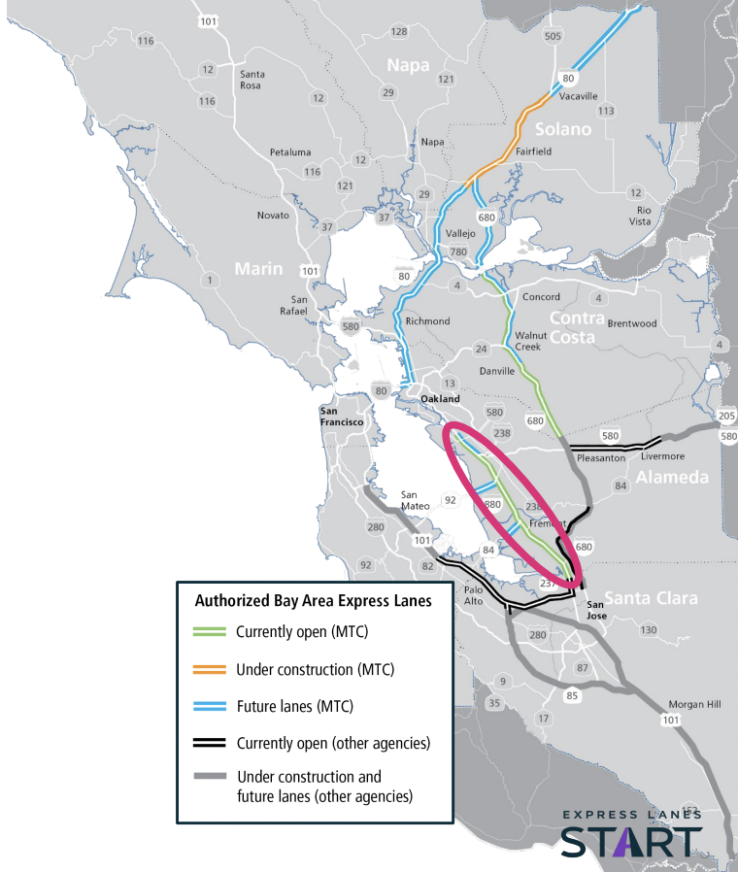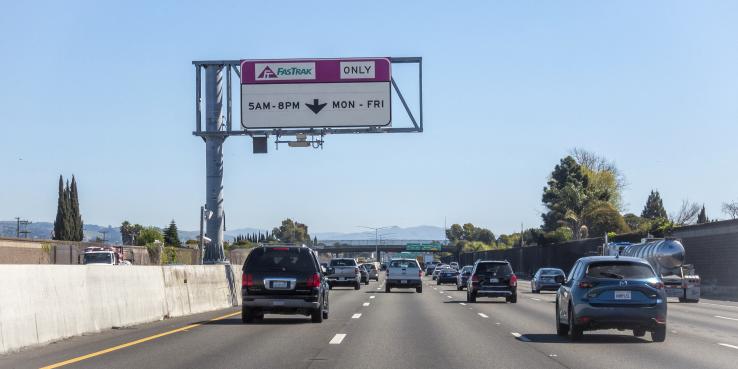Tolling roads is a popular tool to combat congestion, address the environmental impact of driving, and fund necessary transit services and infrastructure. Its increasing use makes identifying ways to keep roads accessible for all people essential. In April, the Metropolitan Transportation Commission (MTC) announced a pilot program to reduce the undue cost burden of tolls for lower-income drivers on I-880 express lanes. Express Lanes START will help these drivers take advantage of the lanes and give the agency the opportunity to study how reductions in tolling costs can improve equity.
Express Lane START is available for all San Francisco Bay Area residents with an annual income at or below 200% of the federal poverty level, which works out to about $29,000. The program gives participants 50% off the toll if they are driving alone and 75% off if they are driving with another person or using an eligible clean air vehicle. It eliminates the toll for all drivers, regardless of income, if they have three or more people in the car.
The Express Lanes START program provides significant discounts to low-income drives.
Toll Discounts by Income and Occupancy
| Income | Driving alone | Driver and passenger | Three or more people in the vehicle |
| Above 200% of the Federal Poverty Line | No discount | No discount | 100% discount (no toll) |
| Below 200% of the Federal Poverty Line | 50% discount | 75% discount | 100% discount (no toll) |
The I-880 express lanes run for 20 miles in the northbound direction from the Alameda-Santa Clara county line to San Lorenzo, and about 25 miles in the southbound direction from Oakland to the Alameda-Santa Clara county line.
The pilot Express Lanes START program will reduce tolls for low-income drivers on I-880 express lanes (circled in red).

Source: Metropolitan Transportation Commission
Express lanes and other tolls have been criticized because of their regressive pricing structure. Everyone is charged the same amount of money, but that amount represents a larger share of total income for low-income drivers than for more affluent drivers. For families struggling to make ends meet each month, using toll roads is a luxury.
Despite their regressive structure, toll roads can provide significant benefits for lower-income people. Researchers in Washington found that the lowest-income drivers received the greatest benefits per trip, defined as the value of time savings minus the cost of the toll. That’s because lower-income drivers most often choose to use toll roads during peak times, when traffic is at its worst, for urgent tasks, such as getting to work and picking up kids from school on time.
Although lower-income drivers get the largest benefit from using toll roads, they take advantage of the roads less than any other income group. Toll discounts, like those offered by Express Lanes START, can ensure that low-income drivers are able to access toll roads’ travel time savings.
Critically, the discounts will not diminish tolls’ congestion and climate benefits because lower-income drivers can be expected to continue to use toll roads in the way that most drivers use them: as a quick way to get somewhere when running late. The discounts are unlikely to encourage lower-income drivers to use toll roads more than their higher-income neighbors do because the discounts are merely bringing the effect of the tolls on lower-income drivers more in line with the effect they have on higher-income drivers. Tolls disproportionately impact lower-income drivers because their amounts represent a larger share of lower-income drivers’ income. When agencies discount the tolls for lower-income people, they are not eroding tolls’ intended effect. Although the dollar amount of the toll is lower for lower-income drivers than for higher-income drivers, the savings of adding passengers or of not driving are made proportionately similar for both groups because of the discounts.
Say that a $3 toll is equivalent to 1% of the weekly disposable income of a median-income person and 2% of a low-income person’s weekly disposable income. The effect of the toll on the low-income person is double that on the median-income person — that is, doubly discouraging of driving. If the toll is dropped to $1.50 for the low-income person, thus becoming 1% of that person’s weekly disposable income, it has the desired, identical effect for the low-income person and the median-income person.
Express Lanes START represents a great opportunity to investigate how making tolls more equitable can improve the lives of lower-income people without backtracking on climate and congestion goals. This pilot program will provide vital data that will inform the future of tolling, both in the region and across the United States.
